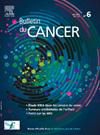Aplasies médullaires sévères acquises dans les pays émergents : prise en charge dès l’indication de l’allogreffe de cellules souches hématopoïétiques jusqu’au suivi postgreffe (SFGM-TC)
IF 1.1
4区 医学
Q4 ONCOLOGY
引用次数: 0
Abstract
La prise en charge des aplasies médullaires acquises et sévères dans les pays émergents est tributaire des moyens de stratification pronostiques, thérapeutiques et logistiques disponibles. Dans le cadre des treizièmes ateliers d’harmonisation des pratiques de greffe de la Société francophone de greffe de moelle et de thérapie cellulaire (SFGM-TC), le groupe de travail s’est basé sur les données de la littérature et sa propre expérience afin d’élaborer des recommandations concernant la greffe de cellules souches hématopoïétiques dans cette indication. L’accès au prélèvement médullaire, à l’irradiation corporelle totale, et au fichier international de donneurs non apparentés reste très difficile, ce qui justifie l’emploi des cellules souches périphériques, des conditionnements à base de chimiothérapie, et parfois le recours à un donneur alternatif intrafamilial. L’atelier recommande une allocellule souche hématopoïétique géno-identique chez tous les patients âgés de moins de 40 ans atteints d’une aplasie médullaire acquise sévère. Une greffe de fichier peut être aussi envisagée en première ligne chez les sujets de moins de 20 ans. Pour les patients âgés de plus de 40 ans, ou n’ayant pas de donneur Human Leucocyte Antigen (HLA) identique, un traitement combinant ciclosporine, sérum antilymphocytaire (SAL) de cheval, eltrombopag ou ciclosporine eltrombopag est recommandé. Si le SAL de cheval et le eltrombopag ne sont pas disponibles, la greffe de cellules souches hématopoïétiques allogéniques géno-identique peut être indiquée en première ligne chez les patients âgés entre 40–60 ans, en bon performance status (PS). En cas d’échec aux traitements immunosuppresseurs, et aux agonistes de la thrombopoïétine, et en cas d’absence de donneur HLA compatible, les allocellules souches hématopoïétiques haplo-identiques avec un conditionnement de type Baltimore modifié sont recommandées si le patient est éligible.
Management of acquired aplastic anemia (AA) in emerging countries depends on the means of prognostic stratification, treatment and logistics available. During the 13th annual harmonization workshop of the francophone Society of bone marrow transplantation and cellular therapy (SFGM-TC), a designated working group reviewed the literature in order to elaborate unified guidelines for allogeneic hematopoietic cell transplantation (Allo-HCT) in this disease. In terms of practice, the conclusions are as follows; The use of anti-tymocyte globuline (ATG) is mainly from rabbit and very little from horse. Access to bone marrow graft, total body irradiation, and the international unrelated donor registries is limited, which justifies the use of peripheral blood stem cells, chemotherapy-based conditioning, and related alternative donor. The workshop recommends matched sibling allo-HCT in all patients aged less than 40 years with acquired severe or very severe AA. For patients aged over than 40 years, or who lack an HLA-identical donor, treatment with the combination of cyclosporin, horse ATG, eltrombopag or cyclosporine, eltrombopag is recommended. If horse ATG and eltrombopag are not available, matched sibling allo-HCT may be indicated as first-line therapy in patients aged between 40–60 years, and good performance status. Although, in patients who have failed immunosuppressive treatments and thrombopoietin agonists, and in the absence of HLA-matched donor, a haplo-identical allo-HCT with modified Baltimore conditioning is recommended.
[新兴国家的后天性重型再生障碍性贫血:从异体造血细胞移植适应症到移植后随访的管理 SFGM-TC]。
新兴国家对获得性再生障碍性贫血(AA)的管理取决于预后分层、治疗和后勤保障手段。在法语国家骨髓移植和细胞治疗协会(SFGM-TC)第13届年度协调研讨会期间,一个指定的工作组对文献进行了审查,以便为该病的异基因造血细胞移植(Allo-HCT)制定统一的指导方针。就实践而言,结论如下:抗成纤维细胞球蛋白(ATG)的使用主要来自兔,很少来自马。骨髓移植、全身照射和国际非亲属捐献者登记都很有限,因此需要使用外周血干细胞、化疗调理和相关替代捐献者。研讨会建议所有年龄小于 40 岁的获得性重度或极重度 AA 患者进行配型同胞异体肝移植。对于年龄超过 40 岁或缺乏 HLA 相同供体的患者,建议使用环孢素、马来酸 ATG、艾曲波巴或环孢素、艾曲波巴联合治疗。如果没有马ATG和艾曲波帕,配型相合的同胞异体肝移植可作为一线疗法,适用于年龄在40-60岁之间、表现良好的患者。不过,对于免疫抑制治疗和促血小板生成素激动剂治疗失败的患者,如果没有 HLA 匹配的供体,则建议采用改良巴尔的摩条件下的单倍体同种异体肝移植。
本文章由计算机程序翻译,如有差异,请以英文原文为准。
求助全文
约1分钟内获得全文
求助全文
来源期刊

Bulletin Du Cancer
医学-肿瘤学
CiteScore
1.90
自引率
16.70%
发文量
224
审稿时长
37 days
期刊介绍:
Without doubt, the ''Bulletin du Cancer'' is the French language publication of reference in the field of cancerology. Official organ of the French Society of Cancer, this journal covers all the information available, whether in the form of original articles or review articles, but also clinical cases and letters to the editor, including various disciplines as onco-hematology, solids tumors, medical oncology, pharmacology, epidemiology, biology as well as fundamental research in cancerology. The journal proposes a clinical and therapeutic approach of high scientific standard and regular updates in knowledge are thus made possible. Articles can be submitted in French or English.
 求助内容:
求助内容: 应助结果提醒方式:
应助结果提醒方式:


